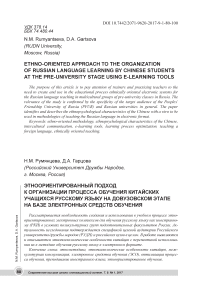Этноориентированный подход к организации процесса обучения китайских учащихся русскому языку на довузовском этапе на базе электронных средств обучения
Автор: Румянцева Наталия Михайловна, Гарцова Дилара Александровна
Журнал: Современная высшая школа: инновационный аспект @journal-rbiu
Рубрика: Инновационные технологии в вузе
Статья в выпуске: 1 (35), 2017 года.
Бесплатный доступ
Рассматривается необходимость создания и использования в учебном процессе этноориентированных электронных комплексов для обучения русскому языку как иностранному (РКИ) в условиях поликультурных групп подготовительных факультетов России. Актуальность исследования подтверждается спецификой целевой аудитории Российского университета дружбы народов (РУДН) и российских вузов в целом. В работе выявляются и описываются этнопсихологические особенности китайцев с перспективой использовния их в методике обучения русскому языку в электронном формате.
Короткий адрес: https://sciup.org/14240103
IDR: 14240103 | УДК: 378.14 | DOI: 10.7442/2071-9620-2017-9-1-80-100
Текст научной статьи Этноориентированный подход к организации процесса обучения китайских учащихся русскому языку на довузовском этапе на базе электронных средств обучения
Today English is one of the most popular languages in the world; 1.5 thousand million people speak English. One in five people at different levels of language skills can talk in this language.
English often is intermediary language for the students who studies abroad. Basic educational programs of universities in the world and majority of electronic resources for the study of foreign languages are created in English language.
In our research, the problem of studying Russian as a foreign language in preuniversity courses of Russian universities is discussed. As it noted, commitment to the fact that students in varying degrees, speak English is modern trend of teaching foreign languages (particularly Russian language). In view of this, the majority of electronic materials, programs, courses for students are based on knowledge of the English language. However, in the practice of teaching Russian as a foreign language situation where the student does not speak not only English, but also in any other European language (mediator) which certainly affects both the quality of education and the rate of development of the Russian language is common. Furthermore, this adversely affects the process of adaptation of pupils to the new environment in general. As an example, students from China and Vietnam have a harder time of their English-speaking classmates at the initial stage of education due to factors indicated. Students from Southeast Asia have many problems in education and adaptation [10].
The creation of ethnically oriented elearning courses (complexes), which would include all aspects of the study of language (phonetics, grammar, vocabulary), the language of their future profession, as well as the socio-cultural aspect is offered in order to optimize the learning process, a better adaptation of foreign students and to improve the quality of Russian language teaching.
To make successful the process of teaching with a certain contingent of foreign students - in this case the Chinese - teacher of the Russian language as a foreign language should possess multi-faceted information: geographic, socio-political information on the country from which came the students, knowledge of the language system of their mother tongue, especially their communicative behavior etc. Such information is contained piecemeal in many works on sociology, ethno-psychology, ethnopsycholinguistics, and comparative linguistic studies. However, today, the first attempts for the systematic and complete description of the certain national contingent for teaching Russian as a foreign language are undertaken [2].
As an example, several works devoted to the study of ethno-psychological features of Russian language teaching of different peoples are given:
-
1) studies on the Chinese audience: I.E. Bobrysheva "Accounting Lingvo-methodical national traditions in teaching Chinese students Russian as a foreign language in the conditions Russian language environment (initial stage) [3]; T.M. Balykhina, Zhao Yu River "From technique to etnomethodology. Neach-ing Chinese students Russian language: problems and ways to overcome them "[2]; O.V. Nizkoshapkina "etnometh-odologycal system of teaching Chinese students to read with the use of infocommunication resources" [14];
-
2) a study on the Greek audience: H.E. Kalita "Distance teaching students of Russian verbs of motion in a training course for Russian as a foreign language (RKI) using mobile applications (ethnically oriented model of the course of study for the Greek audience, A2-B1 levels)" [9];
-
3) studies on the Korean audience, S.A. Asanova "Lingvo methodical trainer in e-learning system RSL (Russian as a Second Language) (etnomethodical aspect)" [1]; K.A. Deponyan "Nationally oriented approach to teaching Russian as a foreign language in the Republic of Korea (on the material of Russian anthroponymic system)" [8];
-
4) studies on the Vietnamese audience, M.N. Kozhevnikova "Learning Viet-
Ethno-oriented approach to the organization of Russian language learning by Chinese students at the pre-university stage using e-learning tools
N.M. Rumyantseva, D.A. Gartsova
namese citizens in Russian higher educational institutions: the national-based approach" [11];
-
5) multicultural studies: Pugachev
-
I .A. "Ethnically oriented methodology in multicultural teaching Russian to foreigners" (Arabs, Chinese, Vietnamese, Japanese, arkantsy, Americans, Europeans) [15].
Quite apart from the fact that a certain number of textbooks and teaching aids aimed at different audiences, including the Chinese are exist, the problem is lack of sufficient materials for different levels and aspects of language learning. The lack of ethnically oriented e-learning for the Chinese audience is there as in connection with the global science and technology process this type of educational activity has acquired special importance, and the difficulties faced by students from China to study the Russian language can be overcome to a large extent by the use of the e-lerning tools.
The idea of training of foreign students to Russian language with a focus on national identity was developed in the USSR in the 60-ies of XX century.
The first methods of teaching Russian language, aimed at specific enrollments, was called comparative or "principle of accounting students' native language." It was based on the selection of language differences and the influence of the native language of the system on the process of learning the Russian language (L.V. Szczerba, O.D. Mitrofanov V.G. Kostomarov).
Excessive theorizing and the comparison of the two languages at the expense of practical activities are the disadvantage of this method. According to research (O.D. Mitrofanova and V.G. Kostomarov) "the use of methodological categories accounting students native language is hampered by the lack of pedagogically oriented comparative research" [13].
Currently, national oriented education Russian as foreign language (RFL) is seen in the broader sense. Besides taking into account linguistic characteristics of the native language, focus on cultural and psychological features are considered. Scientists are talking about the need to attract research not only from the field of linguistics, but also from such disciplines as sociology, ethnology, ethnic psychology, pedagogy, history, and cultural studies. A new concept - ethnically oriented training RFL is used by many scientists (T.M. Balykhina, I.A. Pugachev, Zhao Yuytszyan) along with the term "nationally oriented" training RFL (M.N. Kozhevnikova).
It is important to note that at present the two concepts are synonymous, because they do not carry theoretical contradictions and are used by some authors (eg, Pugachev I.A.) as interchangeably. [15]
In today's ethnically oriented teaching methodology RFL principle of active communicativeness is considered as leading, and the principle of taking into account the native language or intermediate language of learners - "an important factor governing the use of the most efficient and effective instructional techniques of mastering general material which are unified arranged" [13].
Nationally oriented comments to standard textbooks are made for the realization of ethno-cultural orientation of training, as in multicultural groups, trainings is taken according to standard textbooks, which does not affect the principle of taking into account students' native language. Some of them are workshops on the Russian language for the students, speaking in English (L.K. Serov N.P. Pushkova, 2000); for students who speak Spanish (M.B. Budilt-seva et al., 1992); for students who speak French (I.A. Pugachev, R.I. Babenko et al, 1991, 1994.); for students who speak Arabic
(L.N. Noreiko, M.A. Katsevich, 1990)), and others.
Today e-learning of appropriate orientation are an important part of ethnically oriented education. Practical training for national contingents with regard to their individual needs could be organized with help of e-learning.
Ethnically oriented e-learning allow you to:
-
1) to reflect the language features, as well as disclose the necessary degree and depth of certain linguistic facts for the national enrollment;
-
2) to present the language material in the required sequence for each national contingent of students;
-
3) toorganize the presentation of language material in various ways (audio, video, etc.), the most relevant for a particular national enrollment;
-
4) to apply different methods of semantiza-tion lexical units;
-
5) to limit the phenomenon of interference with the help of thoughtful instructional techniques and exercises.
Ethnodifferentiating features of the Chinese audience
Ethnopsychological and ethno-cultural features of the Chinese
Speaking about the ethno-psychological features of the Chinese, a high level of mnemonic abilities (classification, memorizing), developed intuition, visual channel of perception and visual-motor memory type, active use of analogy, contextual guessing, well-developed creative thinking should be mentioned [16; 2].
Communicative methods of teaching RFL [12] is used in Russian, which focuses on the development of abstract thinking, and therefore do not always correspond to the cognitive characteristics of the Chinese people. In addition, talking about the initial stage of training, it must be remembered that the Chinese students in this period have not yet mastered the new activities: analysis, comparison, expressing an opinion on the topic. They find it difficult to repeat the text, as in the middle and higher schools of China's main method of learning is learning the material by heart.
Thus, the teaching Chinese to Russian, it is necessary to continuously develop their abstract thinking, logical memory and the ability to analyze, to find causal relationships.
It is important to take into account such features as their concern to preserve the honor and face; community or family priority over the individual; strict control and respect for the hierarchy; focus on the monotonous work, detailing, self-education.
Chinese students have peculiar character traits such as isolation, unopened, introversion, which is reflected in their activity in the classroom. Traditional Chinese student’s modesty does not allow them to express their opinions, ask the teacher questions if something is not understood. It is important for the Chinese to preserve the ethics of "person" during the process of communicating with teachers and students.
They are characterized by slowness, slowness of behavior they are used to the forms of written controls.
Based on the foregoing, we can conclude that electronic learning tools (in addition to traditional) for this category of students are best able to adapt to learning in a multicultural group, as they allow to work independently, without limitation in time, more comfortable relying on the visual channel of perception , a written form of control, etc. [6; 7].
Features of the Chinese language: Phonetics
When teaching Chinese to Russian linguistic features of the Chinese language that refers to the insulating type of languages, characterized by the absence of forms of inflection, expression of syntactic relations mainly through word order should be taken into account. Therefore, there are some problems with phonetic during teaching Chinese to Russian. Drill down the linguistic features of the Chinese language, in particular, phonetic [3].
As it is known, the phonetic system of the Chinese language is fundamentally differ from the system of the Russian language: different use of organs of speech needed for sound generation, variant degrees of inten-
Ethno-oriented approach to the organization of Russian language learning by Chinese students at the pre-university stage using e-learning tools
N.M. Rumyantseva, D.A. Gartsova
sity, expiratory force, and the nature of the work of the vocal cords. In Chinese, there is no traditional division of words into sounds, phonemes. Syllable is the main phonetic unit. The Chinese students have a number of difficulties in mastering the phonetic and phonological skills during studying Russian language.
In that context, work on the production of sound is recommended to start with an explanation of articulation, with the use of articulation schemes.
In practice, the best results in the production of the correct articulation of sounds are achieved at the initial stage of training. E-learning tools considering ethno-psycho-logical characteristics of students and ethno-linguistic specifics of the Chinese language should be used to practice phonetic skills.
Analysis of work on learning Chinese phonetics has shown that in the pronunciation of Russian sounds for the Chinese audience is characterized by the following errors:
-
1) non-distinction in Russian language the individual phonemes in all or certain positions; errors of this type occur due to the lack of differences in the native language of the student (eg, undifferentiated [e] and [i]);
-
2) difficulties caused by the fact that the Chinese have a corresponding sound, but it is pronounced with a slightly different articulation (eg, pronunciation [a] with a front or rear articulation); Chinese hear the Russian words, trying to spread them to their phonemes;
-
3) erors "mixed-type": they are associated with the non-distinction of phonemes, and violation of articulation (eg, pronunciation, [i] instead of [yi]);
-
4) articulation of the vowel depends on its position in the word (it is necessary to remember the four basic positions of the vowels under stress: between the hard consonants дом [дом]([dom]) , after the soft consonant before the hard пел ([pel]) [п'эл] , between the soft пять ([pyat']) [п'ат'], After hard before mild боль ([bol']) [бол'] ).
-
5) because of the lack of a corresponding equivalent in Chinese, the consonants [l] and [p], [l '] and [p'] are pronounced much softer, weaker than they should be;
-
6) poorly deafened and voiced consonants, for example, about про[з'ь]ба (pro[d '] ba]) pronounced про[с'ь]ба ( pro[s']ba ) ;
-
7) there is a replacement of Russian sounds by Chinese, for example, the word зу[б] ы (zu[b]y)s is read by зуы ( zu y ) , [д]оска ([d]oska) is rea d
оска ( , [с]лушать ([s]lushat') is readoska) лушать (lushat'); -
8) in connection with the absence of soft consonants in the Chinese language, the word [к' и]но ([k 'i]no) is read [кы]но ([ky]no) but [х'и]мия ([x'i]mia) is read [хы]мия ([xy]mia);
-
9) the Chinese poorly reduce (it is a question of qualitative reduction) vowels in an unstressed syllable, for example, instead of весело [вэс ьлъ] (veselo [ves''l"]) is read in вэсело [вэсэлъ] (veselo [ves'el"]), etc.
Taking into account the above-mentioned features, it is necessary at an early stage of learning (introductory-phonetic course) to give students the possibility of forming phonetic skills through e-learning, as in the digital age range of pedagogical tools has expanded greatly.
Such difficulties can be overcome with the help of linguistic and methodological simulators used both in the classroom and in the process of self-study, as the lesson to a group of teachers is limited in time. The phonetic simulator is able to take into account the individual characteristics of students and present sound standards in a large number in according to the problems of each student that will help the student to develop the correct pronunciation by listening to the recorded voice of a native speaker, imitation and correct their own errors [7].
Features of Chinese grammar
Introduction grammatical material at an early stage is one of the most important stages of the learning process. Implementation of the right of speech and communication activities of students depend on organization of presentation of the grammatical material. The selection of the grammatical material occurs in accordance with the objectives, level and stage of education. In order to establish the most efficient training system selected for the study material it is necessary to focus on a certain number of students to take into account the effect of the native language and expertise in the study of other languages.
Without a doubt, the Russian language is the most difficult for Chinese students. Mainly because in the Chinese language there are not the category of gender, number, case, and animacy/ inanimateness. Category of time in the Chinese language is expressed by the use of words, number, adverbs and suffixes of present, past or future tense.
The type and verb conjugations are expressed in the text with the help of the context, suffix or doubling words. In the absence of the Chinese language, a considerable number of grammatical categories that exist in the Russian grammatical system for quite a while, shaping elements of Russian words are for the Chinese only outward signs of the word. For this reason, in the minds of Chinese students there is separation of the grammatical form of the Russian word and its semantic meaning [14].
The Chinese syntax system is characterized by a fixed grammatically meaningful order of words in a sentence that influences the grammatical role of words and their connection. Variability in order of words in Russian sentence is a considerable challenge for the assimilation of Chinese students.
Development of e-learning tools based on ethnic characteristics of Chinese stu- dents, will certainly contribute to the effectiveness of the learning process, formation of a phonetic and grammatical skills, also the acquisition of communicative skills needed by students.
Experiment and results of the research
The experiment was conducted based on the Russian Peoples' Friendship University at the Department of Russian Language No. 3, the Faculty of Russian Language and General Educational Disciplines.
Three study groups participated in the experiment. Eight Chinese students were trained in each group. In the first group, classes were held traditionally, without the use of e-learning. In the second group, training was carried out with using the elearning without taking into account the native language of the students. And in the third group, ethno-oriented e-learning were introduced and the specificity of the native language of the students was taken into account. The tasks were aimed at working out the difficulties specific of this category of students. In the second and third groups, elearning were used from the very beginning of the training in the ratio 1:2. Classes that used special materials developed on the basis of the e-learning were held both in the mode of independent work of students and in the process of classroom work.
After the lapse of the first semester, we compared the results of the performance of three groups in two parameters: formed phonetic and grammatical skills. Figure 1 shows the number of students who successfully mastered the grammatical and phonetic skills, depending on the form of instruction.
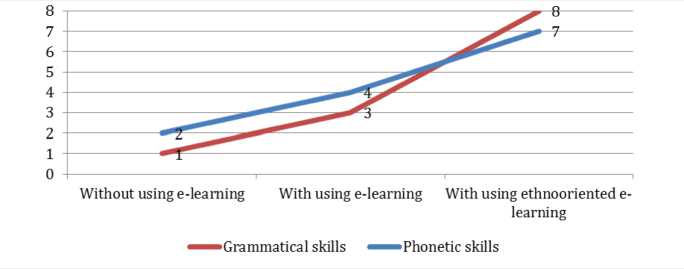
Figure 1. The progress of students, depending on the form of training
Ethno-oriented approach to the organization of Russian language learning by Chinese students at the pre-university stage using e-learning tools
As follows from the graph, the groups in which ethno-oriented ESOs were used in the class most successfully mastered phonetic and grammatical skills.
As part of the experiment, at the beginning of the training the students were given a questionnaire with questions that helped assess the attitude of the students towards this form of conducting classes.
N.M. Rumyantseva, D.A. Gartsova
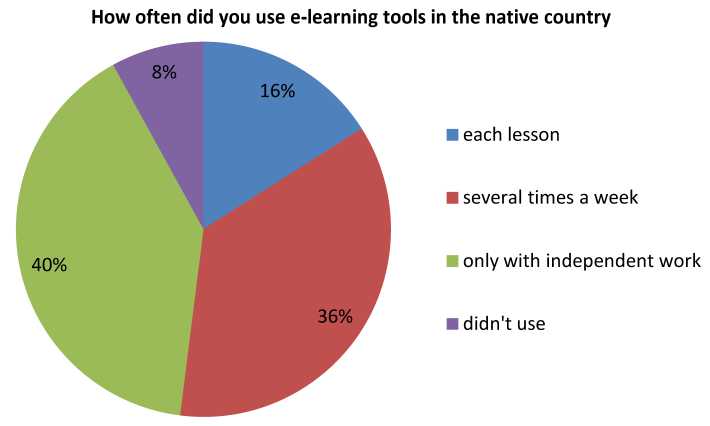
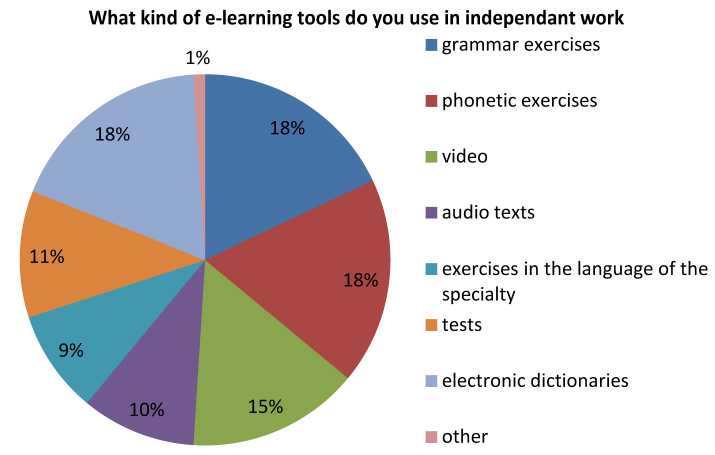
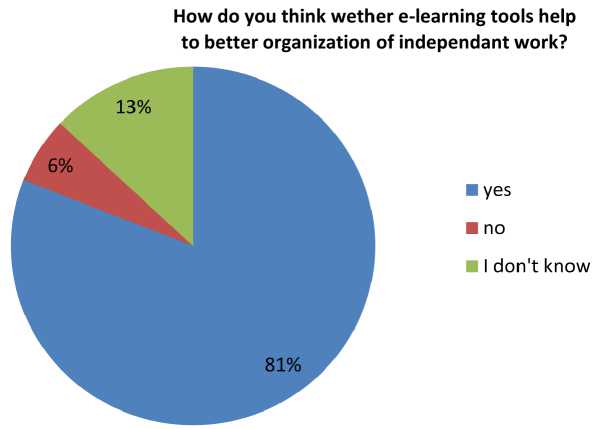
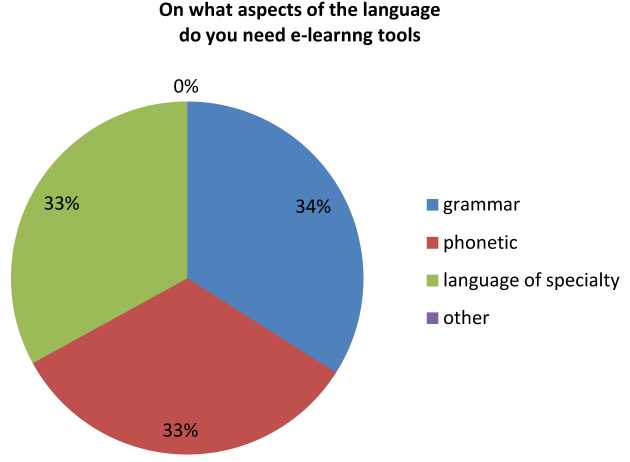
The results of the survey showed that students from China largely (68%) are focused on the use of e-leaning tools in the teaching process. This is due, first of all, to the fact that this form of work is common for the main contingent of the respondents (96%), since it has already been applied at home.
The students equally noted the need for e-learning tools in all aspects of the language (grammar - 34%, phonetics - 33%, language of specialty - 33%).
The rapid transition of the world community to digital methods of working with information created new conditions for the formation of new educational and pedagogical technologies. Computer and network technologies, wide tools of info communication technologies are increasingly turning into levers of increasing the efficiency of the process of searching, processing, storing, transferring and mastering knowledge, skills, skills [5].
The importance of e-learning tools in the practice of teaching foreign languages is not currently questioned. We hypothesized that the learning outcomes will become even more effective if the e-learning tools are designed for a specific national audience, taking into account linguistic, psychological and cultural characteristics.
The assumption that modern foreign applicants and students are largely focused on attracting of the e-learning tools of different directions in the educational process (grammatical, phonetic, sociocultural, etc.) is confirmed. The hypothesis that ethno-oriented ESPs are more effective than universal the e-learning tools was adopted. We associate this fact with the peculiarities of our specific audience.
Chinese students who do not speak English or some other European intermediate language experience great difficulties in adapting and teaching in Russia. It should be noted that the main flow of expelled Chinese students falls precisely at the initial stage of training. This happens in most cases because of poor adaptation to the culture of the country and dropping out of the educational process from the very beginning. When everything around is incomprehensible, the motivation for learning disappears. In this regard, we propose a way to help Chinese students adapt to the educational process and to the new country as a whole from the first lessons. E-learning tools of sociocultural orientation help students do not feel isolated from the culture of the country in which they are located. The informational vacuum is overcome, which develops interest in learning the language. E-learning tools aimed at the acquisition of linguistic competence and applicable from the beginning of training, lay the necessary foundation knowledge and skills required to successfully continuing their studies.
Ethno-oriented approach to the organization of Russian language learning by Chinese students at the pre-university stage using e-learning tools
N.M. Rumyantseva, D.A. Gartsova
Summing up, we can say that modern foreign students and students are eager to use educational technologies that are adequate in time. Electronic means of teaching in the practice of teaching foreign languages for more than a decade have declared their indispensability and didactic capabilities.
Developing this direction in the teaching of foreign languages, we propose to create ethno-oriented e-learning tools aimed at a specific audience, thus realizing one of the main principles of teaching foreign languages - the principle of individualization.
Our study confirmed our assumption that ethno-oriented e-learning tools contribute most to the speedy and better development of all aspects of the Russian language.
Thus, the creation of ethnically oriented educational complex on the basis of e-learning tools for a certain contingent of foreign students allows teachers to:
-
1) to avoid the learning difficulties of a given ethnic contingent;
-
2) to form a complex of ethnomethodical knowledge, skills and abilities necessary to create effective and psychologically comfortable pedagogical interaction with students;
-
3) to organize forms of work effective for a particular contingent (interactive, oral or written, etc.), methods of group and collective interaction;
-
4) to determine the content of training, oriented to a certain ethnic contingent, to work out in detail the topics most vividly reflecting intercultural differences (religious, gender, taboos, etc.) in the process of individual and independent work;
-
5) to create training tools that are effective in working with a certain contingent of students, create variational phonetic, lexical and grammatical tasks, taking into account ethnospecificity, aimed at comparing or presenting facts of the Russian language and Russian culture, which represent a certain complexity for the described contingent of foreign students;
-
6) to realize the possibility of accounting for the ethnicity of students, regardless of their number in the training group;
-
7) effectively use the principle of individualized learning.
Список литературы Этноориентированный подход к организации процесса обучения китайских учащихся русскому языку на довузовском этапе на базе электронных средств обучения
- Asanova S.A. Linguistic Methodology Instrument in the System of E-Learning Russian as a Foreign Language (Ethno-Methodological Aspect): dis.. PhD (ped. sciences). Moscow, 2015. -215 p.
- Balykhina T.M. From a Methodology to an Ethno-Methodology. Teaching Chinese the Russian language: Problems and Ways to Solve Them. Moscow: PFUR, 2010. -344 p.
- Bobrysheva I.Ye. Linguistic and Methodological Traditions in Teaching Russian Language to Foreigners (on example of China). Moscow: 2001. -112 p.
- Vagner V.N. Methods of Teaching Russian Language to English-Speaking and French-Speaking students on the Basis of Cross-Language Comparative Analysis: Phonetics. Graphics. Word Formation. Sentence Structure, Word Order. Parts of Speech]. Moscow: Gumanitarniy izdatelskiy tsentr VLADOS, 2001. -384 p.
- Gartsov A.D. Electronic Linguo-Didactics. Innovations of Language Education. Monograph. Saarbrucken, Germany: Lamber Academic Publishing, 2010. -374 p.
- Gartsova D.A., Gartsov A.D. Theory of Electronic Language Learning in the Aspect of Global Education Restructuring. In L.N. Mikheeva (Ed.), Relevant Issues of the Russian Language and Culture of Speech: Collective Monograph (pp. 249-258). Ivanovo: Ivanovo Chemical and Technological State University, 2014. P. 249-258.
- Gartsova D.A., Rumyantseva N.M. Formation of Communicative Competence of Foreign Students through the Use of e-learning tools (Pre-University Stage).//Vestnik Rossiyskogo univer-89Ethno-oriented approach to the organization of Russian language learning by Chinese students at the pre-university stage using e-learning toolssiteta druzhby narodov. Seriya: Voprosy obrazovaniya. Yazyki i spetsial’nost’. -2015. -№ 4. P. 25-29.
- Deponyan K.A. Nationally Oriented Approach in Teaching Russian as a Foreign Language in Korean Republic (on the Materials of the Russian Anthroponomical System): dis.. PhD (ped. sciences). Mоscow, 2015. -171p.
- Kalita O.N. Distance learning Russian verbs of motion in course of training Russian as a foreign language using mobile applications (Ethnically-oriented model of the training course for the Greek audience, A2-B1 levels): dis.. PhD (ped. sciences). Moscow, 2016. 156 p.
- Kozhevnikova M.N. Pedagogical Conditions of Adaptation of Students from China in the Process of Pre-University Training): dis.. PhD (ped. sciences). Moscow: 2009. 156 p.
- Kozhevnikova M.N. Principles of Nationally Oriented Approach in Teaching Foreign Citizens in Russian Higher School. Moscow: Flinta, 2015. -138 p.
- Kryuchkova L.S., Moschinskaya N.V. Practical Methods of Teaching Russian as a Foreign Language. A Manual for Novice Teachers, Students-Philologists and Linguists Specializing in RFL. Moscow: Flinta; Nauka, 2009. -480 p.
- Mitrofanova O.D., Kostomarov V.G. Methods of Teaching Russian as a Foreign Language. Moscow: 1990. -267 p.
- Nizkoshapkina, O.V. Ethno-Methodological System of Teaching Chinese Students Reading Using Info-Communications Resources: dis.. PhD (ped. sciences). Moscow, 2016. -234 p.
- Pugachyov I.A. Ethno-Oriented Methodology in Multicultural Teaching of the Russian Language: monograph. Moscow: PFUR, 2010. -284 p.
- Shevelyova S.I. Forming Intercultural Competence of Students from the Asia Pacic at Pre-University Stage: dis.. PhD (ped. sciences). Tomsk, 2015. -227 p. [in Russian
- Асанова С.А. Лингвометодический тренажёр в системе электронных средств обучения РКИ (этнометодический аспект): дисс. … к.п.н. -Москва, 2015. -215 с.
- Балыхина Т.М. От методике к этнометодике. Обучение китайцев русскому языку: проблемы и пути их преодоления. -Москва: РУДН, 2010. -344 с.
- Бобрышева И.Е. Учет национальных лингвометодических традиций в обучении русскому языку иностранцев (на примере Китая). -М.: Компания Спутник +, 2001. -112 с.
- Вагнер В.Н. Методика преподавания русского языка англоговорящим и франкоговорящим на основе межъязыкового сопоставительного анализа: Фонетика. Графика. Словообразование. Структуры предложений, порядок слов. Части речи. -М.: Гуманит. изд. центр ВЛАДОС, 2001. -384 с.
- Гарцов А.Д. Электронная лингводидактика//Инновации языкового образования: монография: -Саарбрюке, Lamber Academic Pablishing, Германия, 2010. -374 c.
- Гарцова Д.А. Теория электронного языкового обучения в аспекте реформирования глобального образования//Актуальные проблемы русского языка и культуры речи: монография/под ред. Л.Н. Михеева. -Иваново: Ивановский химико-технологический государственный университет, 2014. С. 249-258.
- Гарцова Д.А. Формирование коммуникативной компетенции иностранных учащихся посредством использования электронных средств обучения (довузовский этап)//Вестник Российского университета дружбы народов. Серия: Вопросы образования. Языки и специальность. -2015. -№4. С. 25-29.
- Депонян К.А. Национально ориентированный подход к обучению русскому языку как иностранному в республике Корея (на материале русской антропонимической системы: дисс. … к.п.н. -Москва, 2015. -171 с.
- Калита О.Н. Дистанционное обучение русским глаголам движения в учебном курсе по РКИ с использованием мобильных приложений (этноориентированная модель курсового обучения для греческой аудитории, уровни А2-В1): автореф. дисс. … к.п.н. -Москва, 2016. -21 с.
- Кожевникова М.Н. Педагогические условия адаптации учащихся из КНР в процессе довузовской подготовки: дисс. … к.п.н. -Москва, 2009. -156 с.
- Кожевникова М.Н. Обучение граждан Вьетнама в российских вузах: национально ориентированный подход: монография/Кожевникова М.Н., Ременцов А.Н., Ременцова Н.А. -М.: Флинта: Наука, 2015. -138 с.
- Крючкова Л.С., Мощинская Н.В. Практическая методика обучения русскому языку как иностранному: учебное пособие для начинающего преподавателя, для студентов-филологов и лингвистов, специализирующихся по РКИ. -М.: Флинта: Наука, 2009.-480 с.
- Митрофанова О.Д., Костомаров В.Г. Методика преподавания русского языка как иностранного. -М.: Русский язык, 1990. -267 с.
- Низкошапкина О.В. Этнометодическая система обучения чтению китайских студентов с использованием инфокоммуникационных ресурсов: дисс. … к.п.н. -Москва, 2016. -234 с.
- Пугачев И.А. Этноориентированная методика в поликультурном преподавании русского языка: монография. -Москва: РУДН, 2010. -284 с.
- Шевелёва С.И. Формирование межкультурной компетенции обучающихся из стран азиатско-тихоокеанского региона на этапе предвузовской подготовки: дисс. … к.п.н: -Томск, 2015. -227 с

